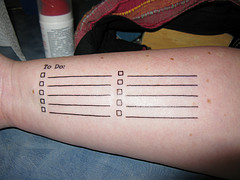 Our inboxes are to-do lists dictated by other people: Ping! “Schedule me!” Ping! “Respond to my question!” Ping! Ping! PING! “Make a choice about these twenty things in the next two minutes!!!”
Our inboxes are to-do lists dictated by other people: Ping! “Schedule me!” Ping! “Respond to my question!” Ping! Ping! PING! “Make a choice about these twenty things in the next two minutes!!!”
Every time you email your contacts, you do the same by adding another task to their lists. Out of consideration for their sanity (and karma points), email etiquette means putting effort into composing messages that are easy to process and action.
Subject-only email and five sentence messages are great goals, but sharing information-rich material calls for longer emails, so organization is essential. As Baydin Co-Founder Aye Moah points out, “It’s incredibly frustrating to receive long-winded email that isn’t specific. I end up wasting time trying to figure out the point of the email–was it informing me of something, asking a question, or requesting action?”
Avoid frustrating recipients and increase your odds of getting a response by following these five steps for writing efficient email:
Five Steps for Writing Efficient Email:
-
Subject lines: Subject lines should be specific enough to (a) indicate what’s coming in the message and (b) make the message easily searchable from the archive folder. Including this information in the subject line is important because it allows your recipient to gauge how urgent the message is. For example, the subject line, “FYI–Notes from last Friday’s VP meeting” is something your recipient can archive and search for as needed, whereas the subject line “Question about this afternoon’s meeting–Need response by 12pm” tells your recipient to take action immediately. Vague subject lines like, “Follow up from yesterday” or “Presentation,” don’t supply this information and are therefore more likely to be lost in the abyss of the archive folder.
-
Organization: While you might be a pro at literary analysis, email is not the right place to test your recipients’ skills. Get to the point, ideally using bullet points or numbered lists. These allow your recipient to quickly process the main ideas of your email rather than digging through multiple paragraphs.
-
Details: Leaving out important details in the initial message means your recipient has to email you back with questions, and before long four extra steps have been added to the process. Who’s got time for that?! Double-check that you included all information the first time around. For example:
-
If you’re asking for a meeting, include the goal: how will it add value for both parties?
-
Is there a deadline the recipient should be aware of?
-
If you’re listing options (restaurants, meeting times, bridesmaids dresses), what’s your preference?
-
-
Length: As you’re composing a message, ask yourself whether the information is essential to your recipient. If not, don’t include it. Informative emails sent to a large group have a tendency to get lengthy, so it’s good etiquette to include a quick summary at the beginning of the email with the tag TLDR, “too long don’t read,” which warns readers, “Hey, this message is long and informative, so maybe scan the summary and then Boomerang it back to your inbox when you have time to read the whole thing.”
-
Call to Action (CTA): Including a specific CTA at the conclusion of your message like, “Please respond with a few times you’re available to meet next week,” reinforces the purpose of your message by making your expectations crystal clear. Now, it’s easy for your recipient to action the message appropriately, increasing your odds of getting the response you want as quickly as possible.
Have any tips to share about writing efficient email? Let me know in the comments!
Click to Tweet: Earn good karma by writing efficient email! http://bit.ly/153QaNZ @baydin
Edit: We published a full article on email etiquette since posting this. Check it out!
